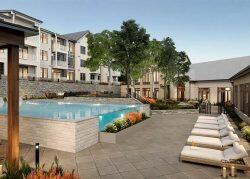
Preservation Austin executive director Lindsey Derrington (Preservation Austin, iStock)
Austin’s development boom is in full swing as plans to bring in more than 20 new towers with hundreds of stories in the next few years, transforming the Texas capital’s skyline.
Some officials and preservation advocates worry the city’s historic character, with its mid-1900’s low-rise buildings, will be forever transformed as high-rise, high-profile towers take over, Community Impact Newspaper reported.
Some of Austin’s current land-use and preservation policies have set the stage for the widespread redevelopment underway downtown. Although the Historic Landmark Commission reviews properties on a case-by-case basis and can recommend their preservation, many redevelopments still move through City Council, according to the publication. Because leaders chose not to designate historical districts, some experts say the trend of redevelopment has already been set.
“[People] want to see something with Austin’s character and soul,” said Lindsey Derrington, executive director of Preservation Austin, a nonprofit focused on the conservation of historic areas and structures. “And where you tip the scales of, all of a sudden, more is new than old, you’re really going to change that dynamic.”
Read more


Areas such as the Rainey Street Historic District, a nationally recognized residential block that quickly became a hub of luxury condo and hotel towers, exemplify how quickly Austin blocks are changing. Even with all the recent development, cranes still dot the downtown skyline as dozens of new tower projects begin, including 98 Red River St., which at 74 stories would be among Austin’s tallest buildings.
“Looking at what we know is in the pipeline, the vertical development downtown will essentially double the size of downtown,” said Dewitt Peart, president and CEO of the Downtown Austin Alliance, an advocacy group focused on downtown.
The types of developments coming to Austin also make the market stand out among growing cities, Peart said, and many towers on the horizon are not dedicated to single-use, incorporating some office, residential, and hotel or retail space.
Resident and corporate demand for mixed-use options could lead to downtown Austin becoming an “18-hour city” where personal and work activities take place just a small distance apart, Peart said.
“Nowadays, your big tenants are the Facebooks, the Googles, now TikTok and Cirrus Logic. Those are the tenants that are really driving the growth of downtown,” said Chad Barrett, managing principal at Aquila Commercial.
He says today’s vertical swell builds on initial changes dating to the mid-2000s when downtown had a more “sleepy” vibe, and signature development has since moved either to the central business district or north to The Domain given tech’s hold over development trends.
District 9 Council Member Kathie Tovo, who represents downtown, said she embraces much of the change the city has seen over her term in office, and has also aimed for years to improve local preservation systems as older offices, homes, warehouses, and restaurants are torn down to pave the way for new towers.
“It’s frustrating how the few tools that we do have are being overwhelmed,” said Ben Heimsath, vice-chair of the Historic Landmark Commission, on May 4. “This is going to be our future over the next several years, and it’s going to be pretty dismal.”
The case, and others recently considered by the commission, also served as an example of the varying pressures that often lead to the loss of older, potentially historic structures without significant pushback.
[Community Impact Newspaper] — James Bell
